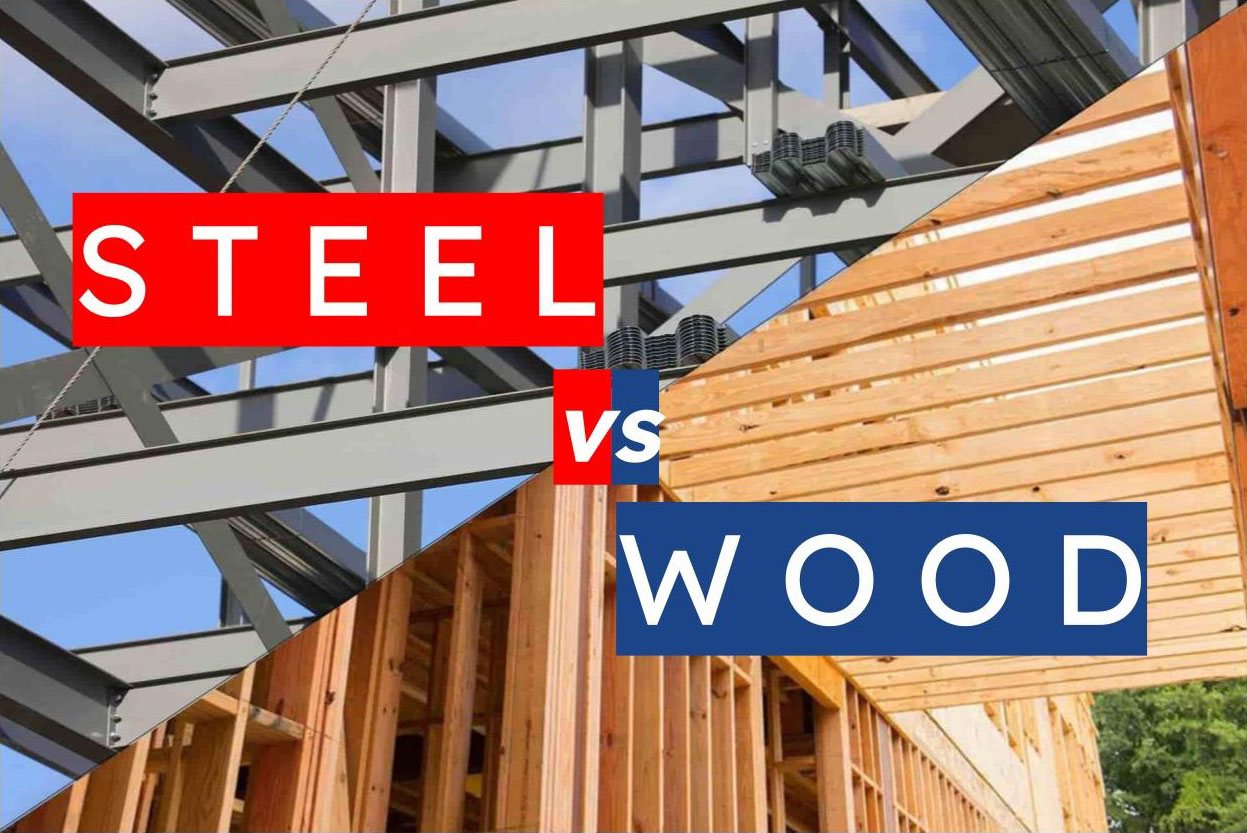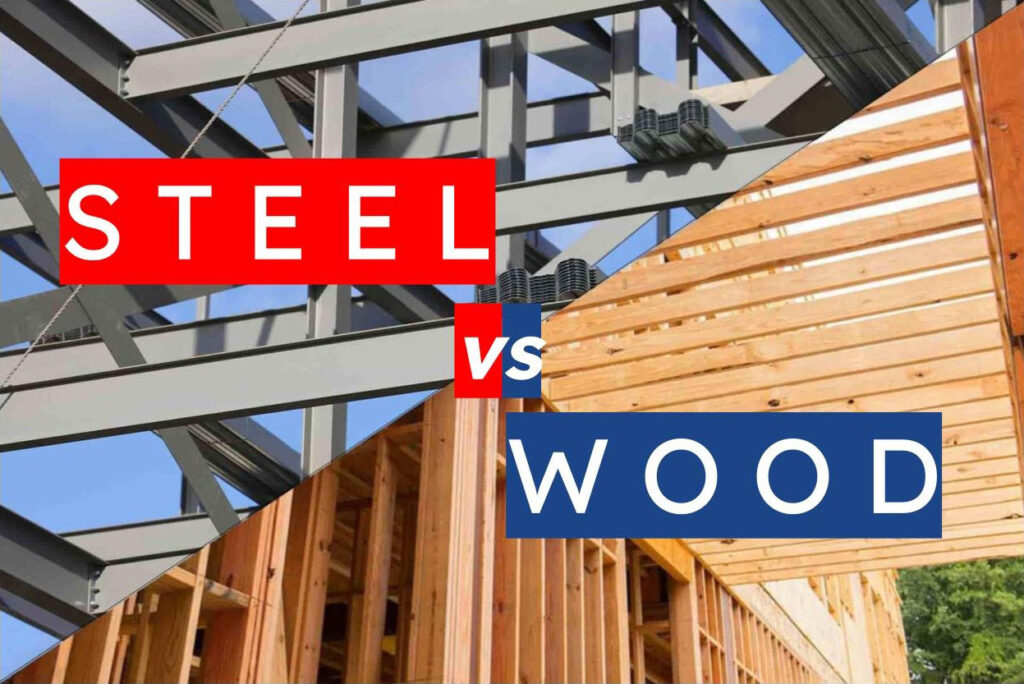
Steel vs. Wood Construction: A Comparative Analysis for Buildings
When it comes to building construction, the choice of materials plays a pivotal role in determining a structure’s strength, durability, sustainability, and overall performance. Two of the most commonly used materials in construction are steel and wood. Each has its unique characteristics and advantages. In this blog post, we will conduct a comparative analysis of steel and wood construction for buildings, examining the pros and cons of each to help you make an informed choice for your next project.
Table of Contents
Strength And Durability
Steel Construction:
- Pros:
- Steel is exceptionally strong and has a high tensile strength, making it ideal for tall buildings and structures requiring significant load-bearing capacity.
- Steel structures are highly durable and can withstand extreme weather conditions, including earthquakes, hurricanes, and heavy snow loads.
- Steel is resistant to pests, rot, and decay, ensuring a long lifespan with minimal maintenance.
- Cons:
- Steel can corrode if not properly protected, requiring regular maintenance such as painting or applying protective coatings.
Wood Construction:
- Pros:
- Wood is a renewable resource, making it an eco-friendly choice for sustainable construction.
- It is a good insulator, providing natural thermal efficiency in buildings.
- Timber construction is cost-effective and relatively easy to work with, reducing labor costs.
- Cons:
- Wood is susceptible to rot, decay, and termite damage, necessitating ongoing maintenance and treatments.
- It has lower tensile strength compared to steel, limiting its use in taller or larger structures.
Environmental Impact
Steel Construction:
- Pros:
- Steel is highly recyclable, and the recycling process uses less energy compared to producing new steel, reducing its environmental footprint.
- Steel buildings can incorporate sustainable features, such as energy-efficient insulation and HVAC systems, to enhance their eco-friendliness.
- Cons:
- The production of steel involves a substantial carbon footprint due to energy-intensive processes, such as smelting and refining.
Wood Construction:
- Pros:
- Wood is a renewable resource, and responsible forestry practices can ensure a sustainable supply of timber.
- Timber construction can store carbon, helping mitigate greenhouse gas emissions.
- Cons:
- Timber production can result in deforestation and habitat destruction if not managed sustainably.
- Some treated wood products contain chemicals that can be harmful to the environment.
Construction Speed and Cost
Steel Construction:
- Pros:
- Steel components can be prefabricated off-site, reducing on-site construction time and labor costs.
- Faster construction timelines can lead to cost savings, especially in commercial projects.
- Cons:
- The initial cost of steel can be higher than wood, although long-term maintenance costs may be lower.
Wood Construction:
- Pros:
- Wood is readily available and cost-effective, making it a budget-friendly choice for many projects.
- Wood framing is well-suited for residential construction, where cost efficiency is often a priority.
- Cons:
- Wood construction may require longer on-site construction times compared to steel due to traditional building techniques.
Design Flexibility
Steel Construction:
- Pros:
- Steel’s high strength-to-weight ratio allows for more open and flexible floor plans.
- It can support larger spans and taller buildings, providing architects with greater design freedom.
- Cons:
- Steel construction may require more complex engineering, potentially increasing design and construction costs.
Wood Construction:
- Pros:
- Timber framing is versatile and well-suited for traditional and contemporary architectural designs.
- Wood offers warmth and aesthetic appeal, making it a popular choice for residential buildings.
- Cons:
- Wood’s structural limitations may restrict design possibilities in larger or more complex structures.
In the debate between steel and wood construction for buildings, there is no one-size-fits-all answer. Each material has its distinct advantages and disadvantages, and the choice should be based on the specific needs, budget, environmental considerations, and architectural vision of the project. Steel excels in strength, durability, and design flexibility, making it ideal for tall and complex structures, while wood offers cost-efficiency, sustainability, and a natural aesthetic that suits residential and some commercial projects. Ultimately, the decision should be guided by a careful assessment of the project’s requirements and priorities.
When it comes to building steel structures, choosing the right partner is essential for a successful project. Solid State Steel stands out as a reliable and trusted option for constructing steel buildings. With our expertise, attention to detail, and commitment to excellence, we ensure high-quality craftsmanship and outstanding results. By working with Solid State Steel, clients can expect a seamless construction process, personalized solutions, and a focus on customer satisfaction. Trust Solid State Steel to bring your steel building project to life, providing durability, functionality, and aesthetic appeal. With our professionalism and dedication, Solid State Steel is the partner you can rely on for a successful steel building construction experience.
Solid State Steel can create a custom building that is tailored to your exact need. With years of experience and professional knowledge of materials, Solid State Steel is ready to create the steel building of your dreams. We work in both residential and commercial capacities, so check out some of our past projects to get inspired

